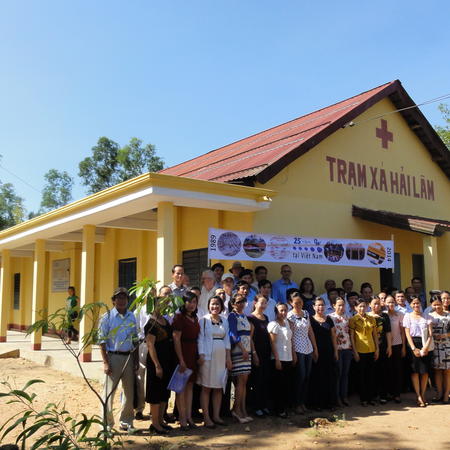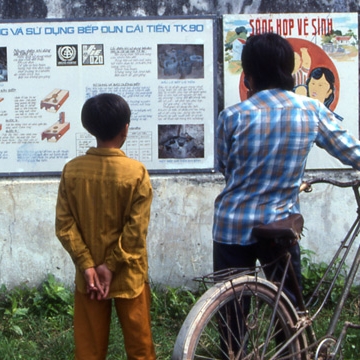CLIMATE CHANGE: A guide to the IPCC's take on extreme events
JOHANNESBURG, 24 November 2011 (IRIN) - Did the heatwave of summer 2003, which killed at least 30,000 people in Europe, have anything to do with climate change? And were the 2010 floods in Pakistan, which affected more than 20 million people, linked to a warming climate?
Various studies have attempted to examine the links between extreme weather events and climate change, and now the world’s most authoritative body on climate science - the Intergovernmental Panel on Climate Change (IPCC) - has spoken out on the issue.
After three years of assessing climate models and new evidence, the panel has released a summary of its special report on Managing the Risks of Extreme Events and Disasters to Advance Climate Change Adaptation - SREX for short. The full report will be released in early 2012.
The IPCC goes beyond determining the influence of climate change on weather extremes now and in the future; it also talks about the risks that could turn these extreme events into disasters, and how to manage them and adapt to the changed circumstances.
Navigating through the summary can sometimes be tricky, and you are never quite sure what a “high or a medium confidence level” means.
IRIN spoke to two IPCC authors for more clarity on the report. Thomas Stocker, head of the climate and environmental physics department at Bern University, Switzerland, a lead author of the report and co-chair of the IPCC Working Group I, which assesses the physical scientific aspects of the climate system, and Richard Klein, a senior research fellow at the Stockholm Environment Institute (SEI) and the lead author of a chapter on managing risks.
Here are 18 information bites to give you a taste of the report
1) Generally speaking, the higher the quality and quantity of weather data and sophisticated climate models, the more certain the scientists are about any projection. So, the rarer an extreme event, the more difficult it is to say whether it is going to become more frequent or intense, as we have little data to make an assessment.
2) What is an extreme rare event? “There are various ways to characterise ‘extreme
events’,” Stocker said. “A widely used concept is the ‘return period’.” This is the frequency at which the event occurs. In this report, an event occurring once in 20 years has been designated an extreme event.
3) Insufficient data on extreme events because they occur rarely means that attributing a single extreme event to anthropogenic, or man-made, global warming is a challenge, said Klein. We cannot therefore directly link the 2003 heat wave to climate change.
4) The SREX report considers in depth nine extreme phenomena: extreme warm and cold days, hottest days, heat waves, heavy precipitation, tropical cyclone activity, extra-tropical storms, droughts, extreme coastal high waters, and patterns of natural variability, said Stocker.
5) There are some projections about sea-level rise - not an extreme event - but because it interacts with extreme coastal high waters after cyclones and storm surges, the scientists said it warranted attention. Sea levels will rise and very high levels of water in coastal areas will be recorded.
“If a cyclone now leads to a high-water level that is just below the protection standard of a coastal city, then in 50 years’ time, due to sea-level rise, a cyclone of the same magnitude (which may well have become more frequent by then) would lead to a high-water level that exceeds the protection standard (if the flood defences haven’t been upgraded),” noted Klein.
6) Many extreme weather events are a result of natural climate variability, the report says. Yet the IPCC found that on a global scale, man-made causes such as the emission of greenhouse gases was influencing extreme daily minimum and maximum temperatures, and extreme high coastal waters.
7) Generally, the higher the emissions and the mean climate change, the more extreme events will change their characteristics, said Stocker. Even relatively small changes in the mean temperature, for example, cause an increase in the number of hottest days.
8) In most land areas where the IPCC found sufficient data on recorded temperatures, Klein said a one-in-20 year hottest day is likely to become a 1-in-2 year event by the end of the 21st century if greenhouse gas emissions continue unchecked. The frequency of recorded extreme low temperatures will decrease.
9) Stocker said it was very likely that the length, frequency, and/or intensity of heatwaves will increase in most land areas.
10) The frequency and intensity of rainfall will increase, especially in areas in high latitudes and tropical regions, and during winter on land in the mid-latitudes.
11) The scientists are uncertain about how tropical cyclones will behave because of lack of data and understanding of the process, and the quality of older data, said Stocker.
“However, the assessment for the projection of tropical cyclone activity concludes [that there will be] a likely increase of maximum wind speed,” he said. The IPCC is highly confident that tropical cyclones - also called typhoons or hurricanes - will become more intense, but not in all oceans.
12) The IPCC cannot say with complete certainty that in the coming century droughts will intensify in southern Europe, the Mediterranean region, central Europe, central North America, Central America, Mexico, northeast Brazil and southern Africa, as projected by some climate models.
This is because of a “range of results that are obtained by projections from current climate models, and the way this phenomenon is simulated in these models,” Stocker explained. “New studies showed that the influence of soil moisture is very important, and these processes are not simulated comprehensively in all the climate models that were analysed.”
13) “This IPCC report was the first time climate scientists worked together with adaptation experts and disaster scholars,” Klein noted. “The collaboration has led to a unique outcome, both from a scientific and a policy perspective, which may well prove to be an important breakthrough in advancing efforts to reduce vulnerability to climate extremes and disasters around the world.”
14) From 1970 to 2008, more than 95 percent of disaster-related deaths occurred in developing countries.
15) There is robust evidence showing that a repeated process of learning through monitoring, research, evaluation, and innovation can reduce disaster risk.
16) The vulnerability of countries and people is a key factor in disaster losses, but it is not well accounted for in studies that examine links with climate change.
"It is clear that much can be done to reduce vulnerability to climate extremes by addressing socio-economic determinants of vulnerability. This may well be more effective in the short run than reducing greenhouse gases - which is not to say that we don’t also need to do that," said Klein.
"However, the policy discourse of adaptation in the UNFCCC [the UN Framework Convention on Climate Change] and in many countries still focuses on addressing climate risk and not on promoting socio-economic development."
17) Development is key to reducing disaster risk, said Lisa Schipper, a senior scientist at SEI and the lead author of the chapter on the determinants of risk in the report. "This means we have to focus on reduction of vulnerability through sustainable development. This way we will be able to reach many of the development goals while also reducing risk, and thereby helping to ensure the sustainability of development efforts."
18) Tailor risk management to local needs. Combine local knowledge with scientific and technical expertise to help communities reduce their risk and adapt to climate change.
In a taste of what to expect from the full report, the summary provides snapshots of case studies undertaken for the report, with a likely scenario pointing out the risk factors in a particular area, and what can be done to manage or adapt to them. For instance, it is likely that rain will increase in East Africa, which could cause flash floods in the Kenyan capital, Nairobi.
It also lists the risk factors - rapid growth of informal settlements, weak building construction, settlements built near rivers, inadequate drainage - and suggests actions to manage the risks, such as reducing poverty, strengthening buildings, setting up early warning systems, and improving drainage and sewage.
| More on climate change |
| How to spot a dodgy study |
| Climate change information overload |
| The impact of grey literature on climate projections |
| Climate change in-depth |
| The Gathering Storm |











